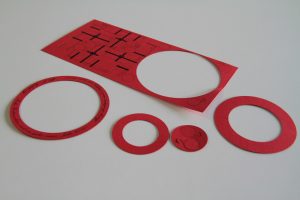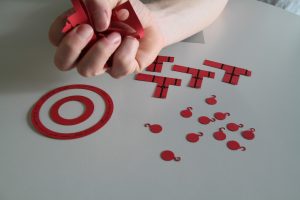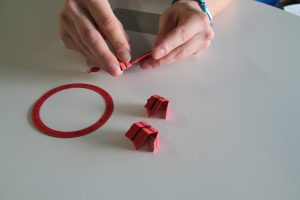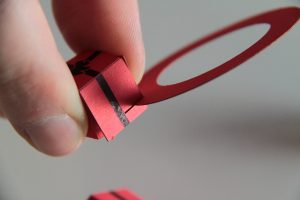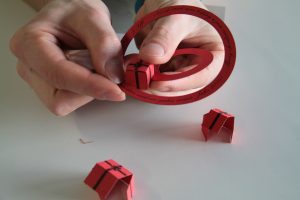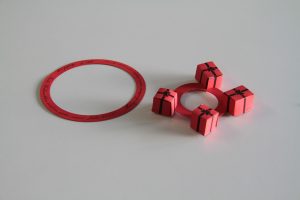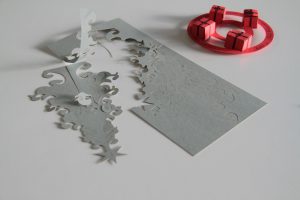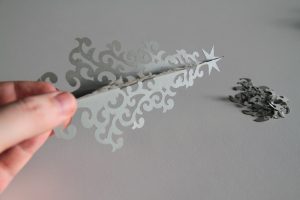Dear colleagues and friends,
we hope you received your exclusive hcilab ornament construction kit, version 2.0 (instructions for last year’s Christmas box you find here). To fully enjoy the hcilab Christmas experience, here are 10 quick steps to a successful assembly:
First, a sneaky peak at the expected result:
 The Christmas tree ingredients (if you have not received your kit before New Year’s eve, feel free to reach out to us and we’ll send you the PDF, so all you need is a laser cutter and some paper):
The Christmas tree ingredients (if you have not received your kit before New Year’s eve, feel free to reach out to us and we’ll send you the PDF, so all you need is a laser cutter and some paper):
Step 1: Free the parts!
Step 2: Pack the packets!
Step 3: Two rings to bind them:
Step 4: Free the tree!
Step 5: Plant the tree!
Step 6: Ornaments!
Q.e.d.
We are curious about your end results and are keen to receive a picture of the final version of your ornament. Feel free to email it to us, to share your accomplishment with us on facebook or link to it in a blog comment.
It is now already 3 years that the group has moved to the University of Stuttgart and 2013 was full of events. It was great to work with so many of you!
Hosting the Augmented Human 2013 conference, was a highlight for us in Stuttgart – if you have not have seen the photos, please have a look at: http://www.hcilab.org/ah2013/photos
As an additional treat we have attached to this Christmas packet a quick overview which lists several projects and topics in the field of human computer interaction we have been working on.
We have concluded the PD-Net project. We showed some results on interaction issues in CHI2013 and a study of cognititive effects of interaction at PerDis2013:
Florian Alt, Alireza Sahami Shirazi, Thomas Kubitza, and Albrecht Schmidt. 2013. Interaction techniques for creating and exchanging content with public displays. In Proceedings of the SIGCHI Conference on Human Factors in Computing Systems (CHI ’13). ACM, New York, NY, USA, 1709-1718. DOI=10.1145/2470654.2466226
Florian Alt, Stefan Schneegass, Michael Girgis, and Albrecht Schmidt. 2013. Cognitive effects of interactive public display applications. In Proceedings of the 2nd ACM International Symposium on Pervasive Displays (PerDis ’13). ACM, New York, NY, USA, 13-18. DOI=10.1145/2491568.2491572
A Google-Scholar page with a list of papers that came out of the project is available at: http://scholar.google.de/citations?user=ZnNpnuQAAAAJ&hl=en
In the area of Automotive User interfaces we worked on various topics, including 3D interaction and physiological data collection. This is published in the following papers, but also includes a publicly available dataset:
Broy, Nora, Florian Alt, Stefan Schneegass, Niels Henze, and Albrecht Schmidt. “Perceiving layered information on 3D displays using binocular disparity.” In Proceedings of the 2nd ACM International Symposium on Pervasive Displays, pp. 61-66. ACM, 2013.
Stefan Schneegass, Bastian Pfleging, Nora Broy, Frederik Heinrich, and Albrecht Schmidt. 2013. A data set of real world driving to assess driver workload. In Proceedings of the 5th International Conference on Automotive User Interfaces and Interactive Vehicular Applications (AutomotiveUI ’13). ACM, New York, NY, USA, 150-157. DOI=10.1145/2516540.2516561
In tangible interaction we continued to work with Tanja Döring which resulted in a paper at TEI2013:
Tanja Döring, Axel Sylvester, and Albrecht Schmidt. 2013. A design space for ephemeral user interfaces. In Proceedings of the 7th International Conference on Tangible, Embedded and Embodied Interaction (TEI ’13). ACM, New York, NY, USA, 75-82. DOI=10.1145/2460625.2460637
Connecting the physical with the virtual world is at the heart of some of our projects. With the WebClip we have created a devices that provides a physical UI for any touch screen device:
Thomas Kubitza, Norman Pohl, Tilman Dingler, and Albrecht Schmidt. 2013. WebClip: a connector for ubiquitous physical input and output for touch screen devices. In Proceedings of the 2013 ACM international joint conference on Pervasive and ubiquitous computing (UbiComp ’13). ACM, New York, NY, USA, 387-390. DOI=10.1145/2493432.2493520
On a conceptual level this holds many challenges, that we investigate in the meSch project:
Daniela Petrelli, Luigina Ciolfi, Dick van Dijk, Eva Hornecker, Elena Not, and Albrecht Schmidt. 2013. Integrating material and digital: a new way for cultural heritage. interactions 20, 4 (July 2013), 58-63. DOI=10.1145/2486227.2486239
Upgrading our servers we could increase the sizes of our Large scale studies. We have published practical guide of how to conduct such study in IEEE Computer:
Henze, Niels, Alireza Sahami Shirazi, Albrecht Schmidt, Martin Pielot, and Florian Michahelles. “Empirical Research through Ubiquitous Data Collection.”Computer 46, no. 6 (2013): 0074-76.
In the MotionEAP project we explore how assistive systems can be used in Manufacturing:
Korn, Oliver, Albrecht Schmidt, and Thomas Hörz. “Augmented manufacturing: a study with impaired persons on assistive systems using in-situ projection.” InProceedings of the 6th International Conference on PErvasive Technologies Related to Assistive Environments, p. 21. ACM, 2013.
There is much more exciting research – please feel free to contact us or to visit our lab! Merry Xmas.

